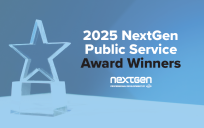The barrier to entry for agencies that adopt innovative technologies and approaches can seem daunting. It’s hard enough to change the hearts and minds of those used to working a certain way, but then there’s the challenge of learning a new process or tool.
For example, DevOps and containers have become synonymous with innovation, but how do agencies make the shift from the current state to embracing these game-changing capabilities?
“Culture is usually the first hurdle that agencies run into,” said Chris Grimm, Solutions Architect at Red Hat, an open-source software solutions provider. “The common sentiment is, ‘This is how we’ve always done it, so why should we change?’”
No matter the size of your organization, it can be challenging to get buy-in from senior leaders while also convincing implementers at various levels that change is not only necessary but transformational to the way they work and deliver services. In a recent interview with GovLoop, Grimm shared how technologies such as Red Hat’s OpenShift, coupled with DevOps, are enabling innovation in government.
Red Hat OpenShift is an open-source container application platform used to develop and deploy enterprise applications. In many ways, it supports a new way of doing business in government by radically simplifying the day-to-day operation of deploying and maintaining large-scale apps.
Using this container application platform, agencies can provide a consistent environment and tools for developers and IT operations teams to package, deliver and manage agency applications — regardless of what the apps look like in development.
“OpenShift can run literally anywhere, and almost on top of anything,” Grimm said. For agencies that want to move applications to the cloud or keep them on-premise, OpenShift allows them to take a hybrid approach and live in both environments while maintaining applications in a consistent manner.
But before any technology can run on a government network, an authority to operate (ATO) must be issued to grant that access. The events leading up to an ATO can take a year or more, with a lengthy, back and forth process between government system owners and those assessing the security of the system.
To streamline this process, the OpenShift platform for government agencies is built with security in mind. Red Hat experts work alongside agencies throughout the ATO process, ensuring that risk management is at the forefront and that security controls are clearly documented. “A major factor for streamlining the ATO process is ensuring developers, security and operations teams all have the same goal in mind,” Grimm said.
Many times, developers build innovative software and want to get it into production, only to have their work halted by the security team. That’s why moving to a DevSecOps model and integrating the work of development, security and operations teams throughout the software development lifecycle is key to moving faster and innovating.
“With these tools, agencies can reduce the barrier-to-entry sooner and benefit from 21st century capabilities to run their missions,” Grimm said.
Takeaway: To ensure your agency can take advantage of secure, innovative technologies, ensure that developers, security and operations teams have the same goal in mind.
This article is an excerpt from GovLoop’s recent guide, “The Top Government Innovations of 2019.” Download the full guide here.




Leave a Reply
You must be logged in to post a comment.